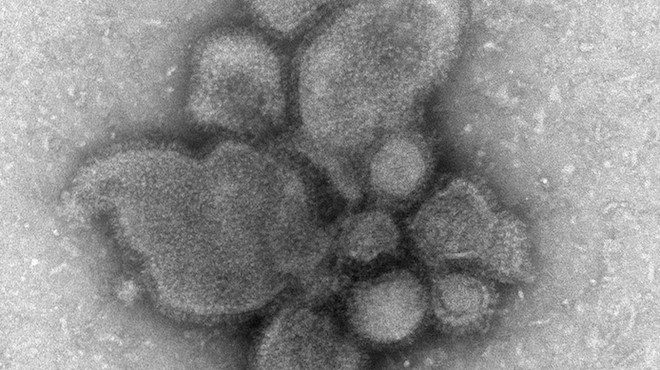
TEM image of influenza A H7N9, CDC
Leadership of the Centers for Disease Control and Prevention will appear today before the Energy and Commerce Committee of the House of Representatives, to answer questions about the lab accidents with flu and anthrax that the CDC disclosed in its press conference last week.
On deck: CDC Director Dr. Thomas Frieden; Dr. Joseph Henderson, Deputy Director of the CDC’s Office of Security and Emergency Preparedness; staff from the Government Accountability Office and the Animal and Plant Health Inspection Services of USDA; and academic experts.
Tuesday night, the witnesses’ written testimony was placed on the Committee’s webpage. Frieden’s says in part:
First, these incidents should never have happened, and the lack of adequate procedures and oversight that allowed them to happen was totally unacceptable. Although it does not appear that these incidents resulted in any illness, and there was no release of pathogens as a result of either event, this does not excuse what happened.
Second, we will take every step possible to prevent any future incident that could put our laboratory scientists, others in the CDC workforce and the broader community, or the public at risk… I am personally overseeing a series of reforms designed to address these specific incidents – but more broadly, recognizing that our challenge is larger than addressing these two specific incidents, I will oversee the careful and deliberate review of existing, and development of new safety practices at all levels of our Agency…
Third, we will explore the broader implications of these incidents and incorporate the lessons learned from them to proactively prevent future incidents at laboratories across the Nation that work with pathogens.
The two accidents, and especially the flu accident — in which a serious strain of avian flu was mistakenly sent to a poultry-research lab, instead of a mild one — have revived concerns about research currently being pursued, not at the CDC, that soups up flu strains to artificial combinations of transmissibility and virulence. The fear, which I’ve written about here and here, is that a lab accident could allow such manmade flu strains to escape.
In advance of the hearing, a group of scientists who have been critical of the lab-enhanced flu work (generally called “gain of function” or “dual use” research) have banded together as the Cambridge Working Group to put their concerns on the record.
Several of them were members of the National Science Advisory Board for Biosecurity, a federally chartered oversight group that has raised concerns about gain-of-function flu research and that mysteriously was partially disbanded with no notice last Sunday night.
Here is the Working Group’s statement. (Click through to the original for their embedded links.):
Recent incidents involving smallpox, anthrax and bird flu in some of the top US laboratories remind us of the fallibility of even the most secure laboratories, reinforcing the urgent need for a thorough reassessment of biosafety. Such incidents have been accelerating and have been occurring on average over twice a week with regulated pathogens in academic and government labs across the country. An accidental infection with any pathogen is concerning. But accident risks with newly created “potential pandemic pathogens” raises grave new concerns. Laboratory creation of highly transmissible, novel strains of dangerous viruses, especially but not limited to influenza, poses substantially increased risks. An accidental infection in such a setting could trigger outbreaks that would be difficult or impossible to control. Historically, new strains of influenza, once they establish transmission in the human population, have infected a quarter or more of the world’s population within two years.
For any experiment, the expected net benefits should outweigh the risks. Experiments involving the creation of potential pandemic pathogens should be curtailed until there has been a quantitative, objective and credible assessment of the risks, potential benefits, and opportunities for risk mitigation, as well as comparison against safer experimental approaches. A modern version of the Asilomar process, which engaged scientists in proposing rules to manage research on recombinant DNA, could be a starting point to identify the best approaches to achieve the global public health goals of defeating pandemic disease and assuring the highest level of safety. Whenever possible, safer approaches should be pursued in preference to any approach that risks an accidental pandemic.
It will be interesting to see whether the group — some of whom have strong government connections — have managed to recruit any of the Congress members at today’s hearing to ask the questions that most concern them.
The members are:
Amir Attaran, University of Ottawa
Barry Bloom, Harvard School of Public Health
Arturo Casadevall, Albert Einstein College of Medicine
Richard Ebright, Rutgers University
Nicholas G. Evans, University of Pennsylvania
David Fisman, University of Toronto Dalla Lana School of Public Health
Alison Galvani, Yale School of Public Health
Peter Hale, Foundation for Vaccine Research
Edward Hammond, Third World Network
Michael Imperiale, University of Michigan
Thomas Inglesby, UPMC Center for Health Security
Marc Lipsitch, Harvard School of Public Health
Michael Osterholm, University of Minnesota/CIDRAP
David Relman, Stanford University
Richard Roberts, New England Biolabs
Marcel Salathé, Pennsylvania State University
Lone Simonsen, George Washington University
Silja Vöneky, University of Freiburg Institute of Public Law, Deutscher Ethikrat